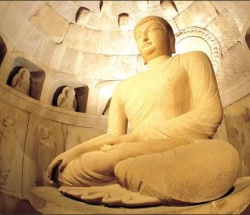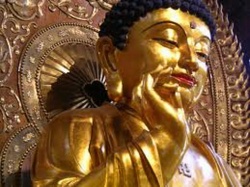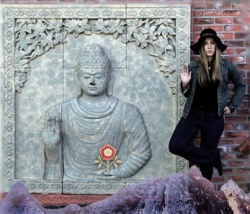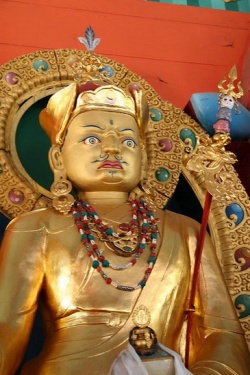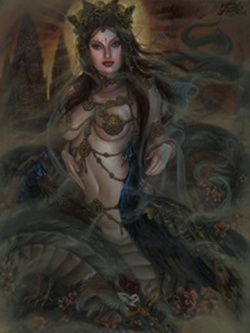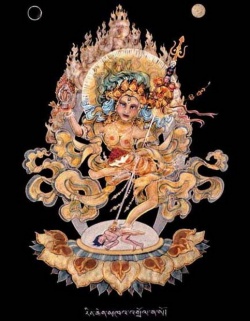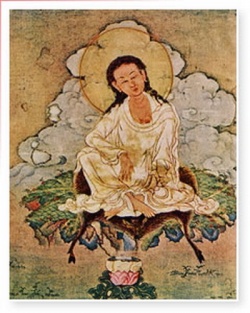Mikyö Dorje - Eighth Karmapa
Mikyö Dorje - Eighth Karmapa
Written by Red Zambala
Thursday, 01 August 2013 08:25
On a fourth day of eleventh month in 1507 in Damchu in Eastern Tibet, Eighth Karmapa Mikyö Dorje was born. After his first breath the new-born opened his eyes and declared:
- Karmapa.
Rumours about the extraordinary child spread around very soon and reached Tashi Paljor, Third Situ Rinpoche, who immediately noticed the place of boy’s birth coincides with that predicted in the letter of Seventh Karmapa. Situ Rinpoche decided to examine the child and questioned his parents. He was satisfied with their answers: father and mother of the next Karmapa had the same names mentioned by Chödrak Gyamtso in the prediction letter and also other circumstances of boy’s birth coincided with description. Situ Rinpoche confirmed that this child is the new incarnation of Karmapa, but asked parents to keep in secret the news to protect Mikyö Dorje from possible provocations. He gave to parents the blessed pills, tea, butter and incense, and said:
- Feed the boy with butter-tea, burn incense and tell him that’s from Situ Rinpoche. Then offer him pills. If your son is really incarnation of Karmapa, he will probably say something. Later notice me about his words.
Father did everything he told and he heard response from small Mikyö Dorje:
- E Ma Ho, don’t doubt, I am Karma.
The news was delivered to Situ Rinpoche and he took the three months old Karmapa with him to Karma Monastery. There the great meditation master G’ser Phowa, who has been a close student of Seventh Karmapa, paid a visit to the kid. During offerings ceremony small Karmapa demonstrated he knows how to use a small drum and a bell. G’ser Phowa asked him:
- If you are Karmapa, do you remember what did you teach me in Tse Lhakang?
Boy replied:
- I gave Mahamudra and Six Yogas of Naropa to you.
In 1512, at age of five, Mikyö Dorje departed to travel to Rivoche. When he was there, Lama Sonam Rinpoche asked him, who he really is? - Boy did lough and said:
Sometimes I am Padmasambhava, sometimes Saraha, but I’m Karmapa too. I have many emanations. In Province of Tsang I have sixteen of them, and one in West of Tibet – a head of large clan.
The same year another candidate to Karmapa’s title appeared, a boy from Amdo region. Gyaltsab Rinpoche was on the way there to examine rights of a child to pretend to the title. But on the way he met Mikyö Dorje instantly felt a spontaneous drive to bow his head. Realizing, the real Karmapa is in front of him, Gyaltsab Rinpoche sent official letter to all Karma Kagyu monasteries where announced that, according to prediction of Padmasambhava, name of the Eighth Karmapa should be Mikyö Dorje. The next year Gyaltsab Dorje ceremonially enthroned the boy as Eighth Karmapa at Tse Lhakang.
Karmapa’s education started when he was seven. His first teacher was Situ Rinpoche – under his guidance Mikyö Dorje learned eight precepts and a few foundational Kagyu teachings. Then boy was travelling to monasteries. In Surmang he had a vision of entire Kagyu transmission lineage; it awakened a clear understanding to him, how vast is the heritage of his tradition. Later on young Karmapa met the great master Sangye Nyenpa, who was asked by Chödrak Gyamtso a while ago to become a successor of his lineage and a teacher of his next incarnation.
After this significant meeting, Mikyö Dorje together with his field camp went to far-reachable areas of Kham. His spiritual abilities and talents were continuing to unfold in a form of visions. In one of them he received instructions from Buddha Shakyamuni himself, who appeared to him in company of two of his closest disciples – Shariputra and Maudgalyayana. At the same location young Karmapa had a very significant dream. Dakini informed him in a dream:
- You are embodiment of all Buddhas of three times.
Very soon Mikyö Dorje with accompanying students and assistants returned to Rivoche and engaged in spiritual activities and charity. Later he again visited his native place in province Damchu. There Padmasambhava appeared to Karmapa and related about their deep connection. :
- I am Padmasambhava and you are my chief student Gyalwa Choyang. Your nature is inseparable from mine, and unity of them is Buddha Vajradhara.
Soon after this dream Mikyö Dorje, inspired by contemplations and remembrance of Karmapa Düsum Khyenpa, did a pilgrimage to Kampo Gangra. It is said he has left his footprints in several caves for meditations in those places.
In 1516, at age of nine, Karmapa received an invitation to visit Sa Tham, a ruler of region of Jung. Graciously agreed, Karmapa moved on the road with all his camp. His arrival was celebrated by a great ceremony. Simplicity and grace of Mikyö Dorje left a deep impact on the ruler and he was giving many honours and precious gifts to young Karmapa. He was not showing a great favour to Buddhism earlier, but starting from the day he met Karmapa he did a great job to provide everything necessary to monasteries in his province. Declaring principle of non-violence, he relaxed a lot his political approach. Mikyö Dorje, while leaving, promised to return in Jung after seven years.
In 1517 young Karmapa entered the most important stage of his education. Except full transmission of Karma Kagyu tradition, during the next three years he received from Lama Sangye Nyenpa also very detailed foundational teachings regarding Teachings of Buddha in all its completeness. Sangye Nyenpa, despite his wealth, was an exceptional example of asceticism characteristic to yogis of Kagyu lineage. When the period of three years was over, Sangye Nyenpa calmly and without regret passed away, knowing Mikyö Dorje has learnt all of his teachings. During the funeral ceremony Karmapa clearly felt the presence of his departed teacher and all knowledge he had received acquired a complete clarity in his mind.
Mikyö Dorje, with his great thirst for knowledge, had much in common with Third Karmapa. He expressed a big talent in linguistics and under guidance of translator Rinchen Tashi learned the grammar of Sanskrit. Besides of this, Eight Karmapa was gladly expressing himself through poetry, painting and sculpture and had a great success with it too. His example of humility and simplicity in daily life was an example for other monks. As a Master of Mahamudra, each moment he realized that everything conditioned is liberated by itself.
In one of his visions a monk appeared to Mikyö Dorje, who said that at the age of previous Buddha Dipankara he was Padmasambhava. In response Karmapa was curious:
-If so, where did your birth in a lotus took place and where you were living?
- And from what is born the space? – Monk replied and disappeared.
By contemplating on this event, Mikyö Dorje came to a realization, that at age of each one of the Thousand Buddhas Padmasambhava appears, as a natural manifestation of enlightening Teaching.
After some time Eighth Karmapa with his camp did a slow-moving travel through Eastern Tibet, teaching local population. All in all over ten thousand people came to his teachings and initiations. During the trip he found and recognized Third Gyaltsab Rinpoche, Lamas Dragpa Paljor and Konchog Yenlag and Fifth Shamarpa. In Mar Khame, Mikyö Dorje carved his own statue from stone. His followers wrote, when work was completed, Karmapa put the statue in front of him and asked it:
- Are you similar to me?
- Yes, very similar, - statue replied.
Then Karmapa clenched in a fist what remained from stone, like a piece of butter, leaving imprints of his palm and fingers on it. And the statue and stone have survived to this day: they are in the Rumtek monastery in Sikkim.
When he arrived in Karma Monastery, Mikyö Dorje met messengers from Hui Tsung, emperor of China. They brought many offerings him on behalf of their ruler and invited Karmapa to China. But Karmapa was feeling soon departure of the emperor and declined this invitation. Chinese took his refusal as an offence, packed their gifts and returned to China, where they found out that the emperor and his wife have just passed away.
From Kham, Mikyö Dorje departed to Central Tibet. In Samding in monastery an offering to him brought a re-incarnating female teacher Dorje Pamo. When he arrived in Tsurphu, he found buildings of this shrine in bad condition and managed renovation works. Lama Surmang Trungpa paid a visit to Karmapa here and saw Karmapa as embodiment of Yidam Chakrasamvara.
After a short period of housekeeping, Mikyö Dorje moved again in the road accompanied by his students. He visited monastery of Kadam school, called Radeng, and from there moved to Gangri Tokar,"White Skull Mountain” – a retreat’s place of Longchenpa – great saint of Nyingma tradition. Imprints of great master’s feet and his horse's hoof marks still remained on rocks around the cave. Afterwards Karmapa’s road lied to the place, where aged Lama Karma Trinley meditated in seclusion. He gave initiations of Kurukulla, Mahakala and Vaishravana to Karmapa. Then they both visited the institute in Lekshey Ling, established by Lama Karma Trinley, and Karmapa gave many teachings there.
In the same year Mikyö Dorje and Karma Trinley met again. This time aged scholar gave teachings of Six Yogas of Naropa to Karmapa, who was twenty-one at the time and he received a full ordination vows to monkhood from Abbot Chodrub Senge, who was considered an incarnation of lama and scholar from Kashmir named Sakya Shri. Karma Trinley was assisting to abbot in this solemn ceremony.
While Karmapa was a guest in Lekshey Ling, Chodrub Senge was long and in great detail teaching him the doctrine of Shentong, called also “empty and something else” (Tib.gzhan stong). Lama asked Mikyö Dorje to preserve and share this very important philosophical view, very popular in traditions Jonang and Nyingma. It was harshly criticised by Gelug school, which adheres to an opposite view rangtong or “empty of itself” (Tib. rang stong). Later on approach Shentong was transmitted in transmission lineage of Karma Kagyu from teacher to student. Once, great scholar Jamgön Kongtrül Lodrö Thaye taught it to Fifteenth Karmapa and made this view a cornerstone of Rime, a movement founded by him. This way Mikyö Dorje can be considered a messenger of Tibetan Renaissance that came in XIX century.
Relationship of Mikyö Dorje with his teacher Karma Trinley was very significant for continuation of Karmapa’s education. He spent around three years with this Lama. During this period Eighth Karmapa studied Five Doctrines of Maitreya, works in logic by Dignaga and Dharmakirti, Abhidharmic treatises of Asanga (Abhidharma-samuchchaya) and Vasubandhu (Abhidharma-kosha), Vinaya texts, most important books of Nagarjuna, Chandrakirti’s treatise “Entering the Middle Path” (Madhyamaka-avatara), “Hevajra-tantra”, works in astrology, and many other Indian texts., related to Mahayana and Vajrayana Buddhism. In addition to the heritage of Indian Buddhism, Karma Trinley introduced to Eighth Karmapa Mikyö Dorje also complete works of Ngoga-translator and Sakya Pandita.
Mikyö Dorje was a good student; he was able to maintain full concentration throughout a long period of his intensive studies. He was constantly thinking on a meaning of texts and conclusions he could draw from there. He always analyzed and doubted any unclear place in a text, and due to that he completely mastered the meaning of a subject of studies. He studied science so much that he had little time for food, and as a result his physical health deteriorated. Karmapa Trinley praised Karmapa as a great scholar, but Mikyö Dorje regarded him as a skilled mentor saying:
- You are on the first stage of Bodhisattva, on the edge between samsara and nirvana. In regard to samsara you are “non-returning one” and you have ability to conscious rebirths.
In conclusion of his intellectual education, Mikyö Dorje dedicated much time to meditations. He had a dream that dakini have brought him to a dwelling place of Shavaripa – great Indian yogi, who transmitted Mahamudra teachings to Maitripa, one of the teachers of Marpa-translator. Shavaripa showed to Karmapa the nature of mind in a dream, adding then:
- Both Samsara and Nirvana arises in the mind. The essence of your mind is primordial wisdom. That’s why there are no stages of realization – everything evolves in the mind.
And Yogi disappeared.
Mikyö Dorje became an author of many texts which provoked many discussions and had a huge influence to his contemporaries and next generations. At age of thirty he wrote commentary to Abhisamaya-lankara, named “Jetsun Ngalso” (Tib. rje btsun ngal so ). When he finished the work he invited a scholar from tradition Gelug, named Ser Jetsun, for a critical dispute about text. This talented master composed his own commentary to the book of Mikyö Dorje, where he wrote: “Karmapa is an incarnation of high Lama and a great scholar. For this reason I cannot criticize him. However, here is my book, named “Response to Karmapa”, written by request of Mikyö Dorje, as a review of his commentary”. In this form a written debate took place between great Master Karmapa and known scholar of tradition Gelug.
Mikyö Dorje has written more than thirty volumes of works, fourteen more than Karma Pakshi did. His works were dedicated to linguistics, fundamentals of Buddhism, Abhidharma, Tantra, Madhyamaka philosophy, visual arts and poetry. He has written also important texts on Mahamudra. Eighth Karmapa is considered a founder and inspirer of a style of art Karma Gadri, he has created many paintings in this technique. In addition, an important part of his heritage is a guide to meditation, known as "Guru Yoga of four times of a day" (Tibetan: thun bzhi bla ma'i rnal 'byor), composed in honour of his first teacher Nyenpa Sangye Rinpoche. It became one of the most important practices in Kamtsang transmission lineage.
In 1546 Mikyö Dorje felt he will soon depart from this life. But Shamar Rinpoche and Pawo Rinpoche were begging their Lama to stay and continue to work. Responding to their persistent requests, Karmapa agreed to prolong his life for a few years more. Together with his traveling camp he went on his last big tour to monasteries and Dharma-centres of Karma Kagyu tradition. He requested his assistants to ease rules of his usual schedule during this trip. He wanted to give an opportunity to everybody who wanted to receive his blessings.
On the road, Mikyö Dorje composed many songs that described his visions. During the one of his most wonderful experiences he saw his Teacher in the body of Chakrasamvara, seated above Vajrayogini’s head. From the Teacher’s body nectar of awareness showed up, transforming all conceptions about samsara and nirvana into ultimate wisdom of Enlightenment. Vajra Hook made this wisdom indestructible. Afterwards in the same dream Karmapa saw how samsara burned in a pot, which was on a three-legged stand.
In another his vision Padmasambhava gathered together all eight Karmapas to create a secret teaching together.
In last years of Karmapa’s life his health constantly deteriorated, but he, in spite of that, was continuing to work hard. In 1554, in south of Tibet, suddenly spread leprosy. Mikyö Dorje went there to put an end to this epidemic. In the centre of affected area, he built black stupa, surrounded by four smaller stupas. The main Stupa represented a symbolical image of being “Naga”, which, according to myths, causes leprosy. Four small stupas were symbolizing arms and legs of this being. Then Karmapa went in the center and by power of his compassion took up in himself all obstacles that led to the spread of this sickness. Epidemic soon stopped and Mikyö Dorje returned to Dagpo Shedrub Ling, monastery of Shamar Rinpoche.
Very soon Karmapa started to have signs of leprosy, and after a while he could not walk. Realizing that his end is near, he put on his clothes and ornaments, characteristic to Buddha-aspects in a state of joy, transmitting inspiration, and so he appeared before his disciples. After this Mikyö Dorje handed a letter with predictions about circumstances of his next birth to Shamar Rinpoche – and left the body at age of forty-seven. His remains were cremated at Tsurphu monastery. Shamar Rinpoche put relics that remained after Karmapa in a special Stupa.
Between disciples of Eighth Karmapa Mikyö Dorje were many high Lamas. Among them the most known were – Shamarpa Konchog Yenlag, Pawo Tsuglag Threngwa, Gyaltsab Dragpa Paljor, Situ Chökyi Gocha and Karma Trinley Legdrub. He also left many artists, doctors and poets to whom he had a large influence.
